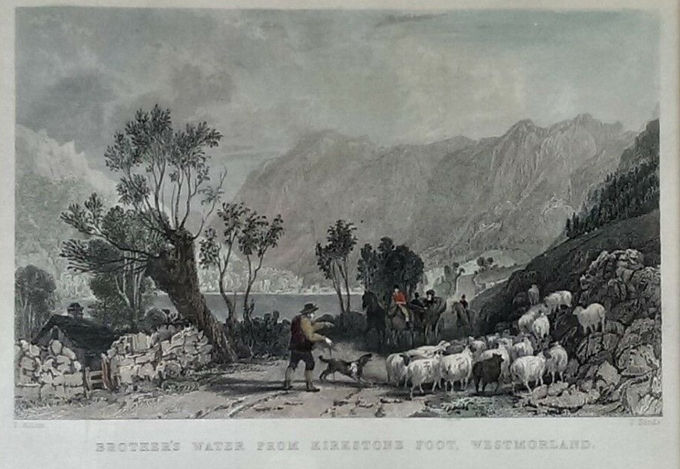
Brothers Water from Kirkstone Foot, Westmoreland by Le Blond & Co
Click on images to show an enlargement in a new window
Brothers Water from Kirkstone Foot, Westmoreland by Le Blond & Co along with the engraving by J Sands after a painting by T Allom
Courtney Lewis in his ‘Le Blond Book 1920’ states that “this well-known lake - named after two brothers who, tradition says, were drowned in it - taken from the descent from the foot of Kirkstone Pass…” In the foreground is the road to Keswick
This print was used as an illustration to Peacock, Mansfield & Sons 'The New Forget-me-not Pocket Book, for 1851, or Ladies' Fashionable Remembrancer’ so would have been printed in 1850 in preparation. It is one of Le Blond earliest prints by the Baxter process, hence Le Blond numbering it as No 2.
Under the print on the left is "Printed in oil colours by Le Blond & Co." and on the right "Licencees, London."
Baxter, on many of his subjects, either claims he designed it or credits the artist. Le Blond only does this on rare occasions, so do we presume that this print is their design?
I recently came across an engraving that proves it wasn’t. Exactly the same title but under the print are the names or the original artist, T Allom and the original engraver, J Sands.
Thomas Allom (1804-1872) was an architect and artist and it is said that between the late 1820’s to the mid-1840’s he produced some 1,500 drawings, undertaking a succession of sketching tours both in the UK and abroad. Most were meant to be used as designs for small steel-engravings that were used in different topographical publications. Many of these trips were on behalf of Fisher & Son and engravings of the Lake District were published in instalments in ‘Fisher’s Picturesque Illustrations of Great Britain and Ireland’ published between 1832-35. The illustrations were also used in Fisher’s annual books, ‘Northern Tourist’ in 1832 and again in 1834/5 and I’m sure most have been used in other Fisher & Son publications as this was their common practice.
We do not know exactly all the books in which this engraving was used but it was definitely in the ‘Northern Tourist’ by Fisher & Co in 1834. The size of that engraving is 10.6 x 15.3 cm so slightly larger than Le Blond’s version at 6 x 9.4 cm but Le Blond’s would have been determined by the size of the pocket book it was meant to illustrate.
The copy of Sand’s engraving has been later hand coloured. It is not exactly the same as the Le Blond print so no question of Le Blond using Sands plate but Le Blond must have been influenced by the engraving or perhaps Allom’s original sketch.

